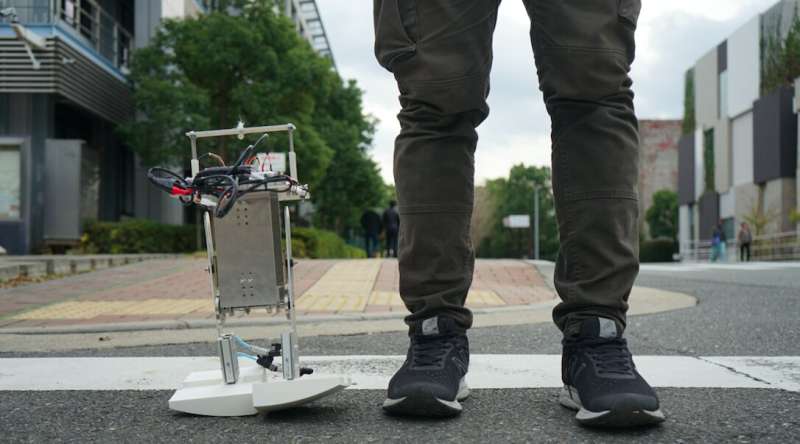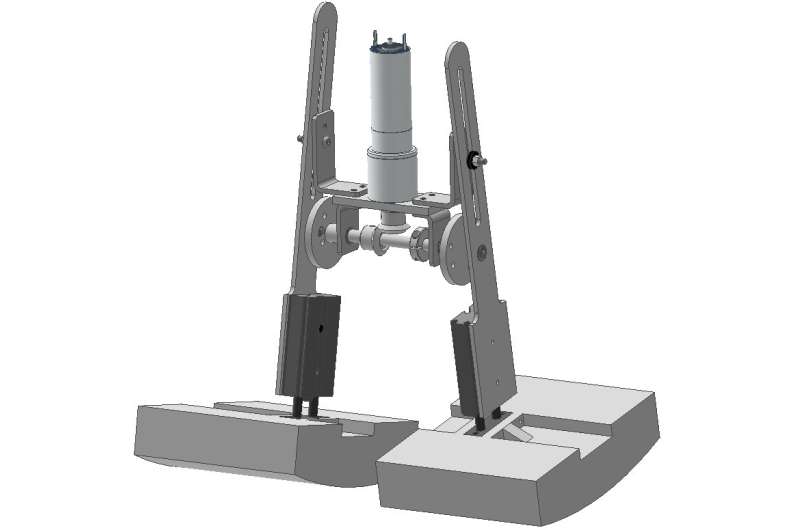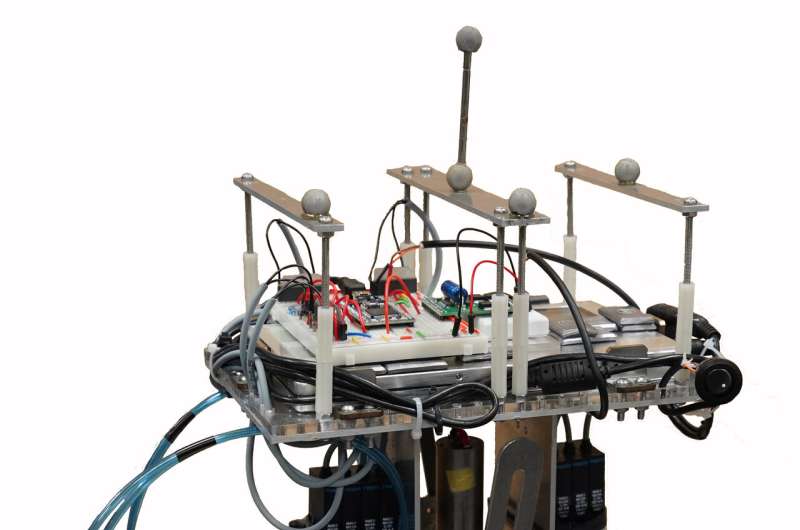March 9, 2020 feature
PedestriANS: A bipedal robot that adapts its walking style in response to environmental changes

Humans are generally able to adapt their walking style based on the environment they are moving in, for instance, speeding up if the consistency of the ground below their feet allows it, slowing down when the floor is slippery, changing direction to avoid puddles or holes in the ground, and so on. To navigate a variety of environments, robots should be able to adapt their walking behavior in a similar way, adjusting their structure in response to environmental changes.
With this in mind, Researchers at Osaka University in Japan have recently created PedestriANS, a bipedal robot that can change some of the physical characteristics and movements of its legs in response to changes in its surrounding environment. This new robot, presented in a paper published in SAGE's journal Adaptive Behavior, can change its walking style using a simple system that connects the movements and configuration of its two legs.
"The main objective of our work is to develop robust robots that can handle disturbances; robots that can accompany humans and walk effectively over even terrains as well as uneven ones such as grass and gravel," Huthaifa Ahmad, one of the researchers who carried out the study, told TechXplore. "To reach this goal, we need to develop robotic systems with an adaptive morphology; because even with most advanced bipedal robots that are available these days, having a precise model of both the robot body and the environment is crucial for them to operate properly."
PedestriANS, the robot developed by Ahmad and his colleagues, relies on an actuator network system (ANS), a design concept introduced in their previous work. In their past studies, the researchers incorporated the same concept in several other applications, including robotic spines, arms and multi-legged robots.

"As its feasibility was demonstrated in several studies, I am currently using the ANS principle in my research to achieve adaptable robots, by utilizing the different interactions among the mounted actuators on their bodies," Ahmad said.
The movements of the robot developed by Ahmad and his colleagues are produced by a single motor, and its legs are linked together through an ANS. Contrarily to other bipedal robots based on complex systems, PedestriANS has a fairly simple structure. The robot adapts to changes in its surrounding environment by exploiting physical characteristics of its legs and interactions between its different components, resulting in a range of different walking behaviors.
"The robot's walking behavior changes by changing the interaction between the actuators of the ANS," Ahmad said. "To produce better behavior, the robot's demands for a certain connection pattern differ based on the given situation. Our work suggests that the best way to realize self-adaptable robots is by enabling them to adjust their morphologies and exploit their whole-body dynamics in response to environmental changes"

The researchers evaluated their robot's performance in a series of experiments. Firstly, they tested how shifts in the robot's morphology impacted its walking behavior by observing its ability to adapt to different ground materials, focusing on changes in its walking style, stability, speed, and the direction in which it moved.
After analyzing the results gathered in this first experiment, Ahmad and his colleagues upgraded the robot's design in a way that allowed it to switch automatically across different connection patterns between its legs. They then conducted a second evaluation and found significant improvements in how the robot adjusted its morphology during locomotion. In this second experiment, PedestriANS effectively produced adaptable walking styles in response to the environment in which it was operating.
In the future, the robot developed by this team of researchers could be used to complete tasks that involve moving around in uncontrolled and continuously changing environments. While PedestriANS can change the type of interaction between its legs to produce different locomotion behaviors that best match its environment, it still can't autonomously identify the morphological adjustments best suited to specific situations. The researchers plan to continue working on the robot to enable this important capability, which is necessary for the robot to operate without continuous human input and guidance.
"The next step in our research will be to realize a control system that can allow the robot to keep providing the best performance during all locomotion phases, autonomously selecting an adequate connection pattern," Ahmad said. "Moreover, by extending the ANS to include more parts of the robot (e.g., upper body), this will increase the possible morphological changes, which in turn reflects on the robot's adaptability."
More information: Huthaifa Ahmad et al. PedestriANS: a bipedal robot with adaptive morphology, Adaptive Behavior (2020). DOI: 10.1177/1059712320905177
© 2020 Science X Network


















